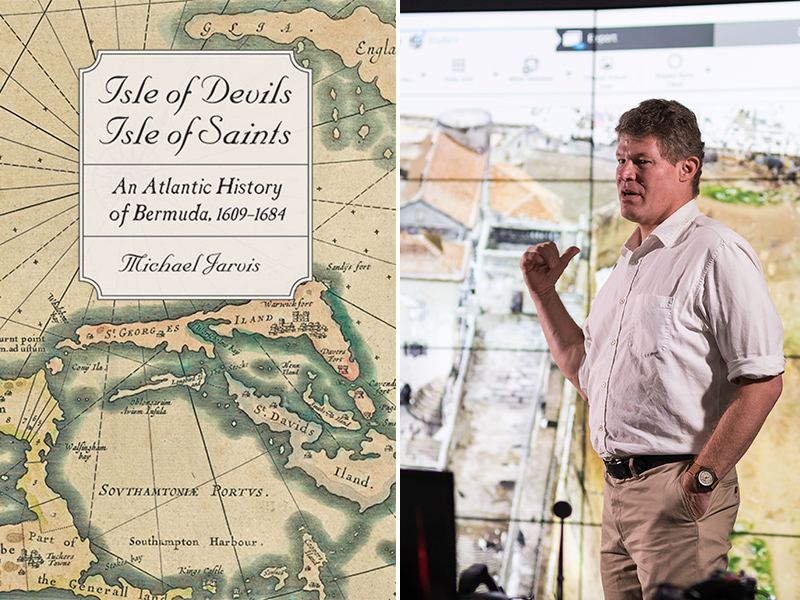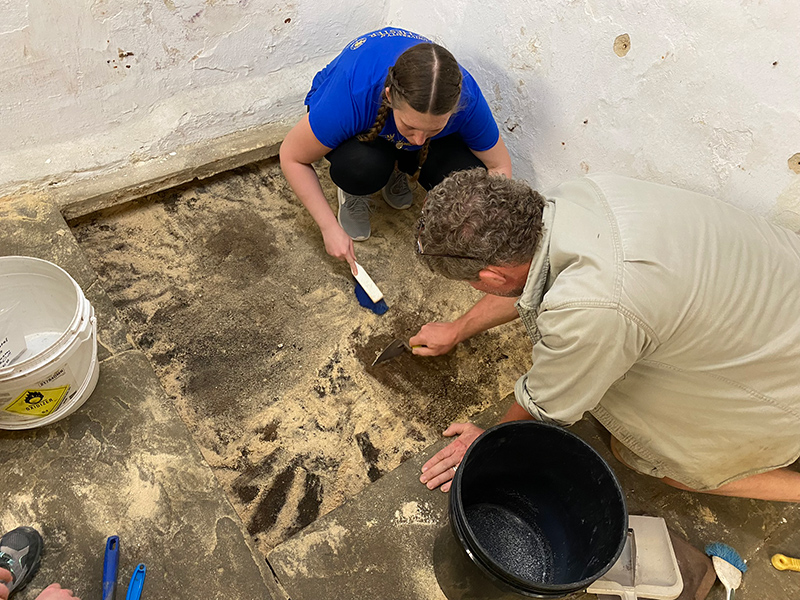A Rochester historian argues Bermuda belongs at the center, not the periphery, of the American colonial story.
Bermuda was a tabula rasa when European explorers first set foot on the North Atlantic archipelago in 1505. No indigenous people, just colonies of shrieking birds, interrupted sporadically by violent storms. Spanish explorer Juan de Bermúdez came, saw little value, and left nothing but his name behind. Permanent settlers wouldn't arrive for another hundred years-and then only by serendipity.
In this case-tragic serendipity. The Sea Venture, an English ship on its way to the colony at Jamestown, got caught in a monster storm and wrecked on a coral reef off Bermuda's shore in 1609. Most of the wreck's survivors eventually made their way to their original destination-albeit months later. But a scant handful stayed behind. Within a few years, Bermuda became a British territory, and with that one of the cradles of English colonization: settled just five years after the first permanent English settlement in Jamestown, Virginia, and eight years before Plymouth.
And yet, reading histories about the early beginnings of the American colonies-the traditional origin stories of the United States-one would be hard pressed to find much, if any, mention of Bermuda.
"When historians have considered it, they usually dismiss it as a curiosity or a failure," writes Michael Jarvis, an associate professor of history at the University of Rochester.
Jarvis has spent most of his academic career trying to fill in the blanks. His latest book, Isle of Devils, Isle of Saints: An Atlantic History of Bermuda, 1609-1684 (John Hopkins University Press, 2022) is his most recent contribution toward that end. As a prequel, it continues the work he started in his first book, In the Eye of All Trade: Bermuda, Bermudians, and the Maritime Atlantic World, 1680-1783 (North Carolina Press, 2010). In Isle of Devils, Isle of Saints, Jarvis makes the case that the small island is nothing less than "the crucible of colonization," and deserves to join historic Jamestown and Plymouth as part of "an English-American historical triangle of origin."

Isle of Devils, Isle of Saints, the new book by associate professor of history Michael Jarvis. (University of Rochester photo / J. Adam Fenster)
Could the American colonies have developed without Bermuda?
Several earlier attempts at establishing colonies on the North American shoreline failed because of hunger, lack of provisions, and harsh environments. But Bermuda started to thrive-which was of considerable consequence for the future United States.
When the newcomers at Jamestown faced starvation, and "desperate settlers resorted to cannibalism," just 800 miles "to the east of this hell" another group of English colonists "found a veritable paradise, an uninhabited island lush with forests and marine life," Jarvis writes.
Bermuda became the first of England's experimental colonial laboratories to produce a successful export staple-Spanish tobacco-which, Jarvis argues, once transferred to the mainland became the foundation of Virginia's economic success. With the success, however, also came Bermuda's dubious distinction as the first English colony to import enslaved African people, thereby developing slavery into "an institution that became ubiquitous throughout English America."
Drawing on three decades of his own research and archaeological work, Jarvis who directs the Smith's Island Archaeology Project in Bermuda, delves into the interplay of slavery, race, gender, and the environment, tracing how "Europeans and Africans became distinctly American" on the island-some 600 miles offshore from what would later become North Carolina.
He argues the histories of several US states and Atlantic and Caribbean islands-such as Virginia, Barbados, Providence Island, Jamaica, the Bahamas, and South Carolina-are firmly intertwined with Bermuda and that historic accounts that "omit or ignore founding Bermudian settlers' presence and contributions are thus incomplete."
Both in his research and teaching, Jarvis fuses history with archaeology and digital media studies. Since his arrival at Rochester in the fall of 2001, he has taken scores of Rochester students along for archaeological field work, most recently this spring to Bermuda's St. George's Island where he and his students, in partnership with the Bermuda National Trust, helped to document and preserve what's still there, as modern Bermuda engages in a frenzy of building and property development.

Historian Michael Jarvis and Skylar DiBlasi '25, an archaeology, technology, and historical structures major, discovered this past spring black charring on the packed floors under the cellar's flagstones of the historic Globe Hotel in St. George, Bermuda, pointing to fire damage. Jarvis regularly takes students along on archaeological digs in Bermuda. Watch Michael Jarvis talk in a Bermuda Tonight episode about his recent archaeological dig in the cellar of the Globe Hotel in St. George's, Bermuda's first capital. (Photo courtesy of Michael Jarvis)
Devil or saint?
Extensive archival and archaeological work allows Jarvis to explore Bermuda's split personality. On the one hand, it was England's first Puritan colony, founded on the idea of building a moral Christian society. On the other, its founders committed, promoted, and helped entrench the profound moral crime of slavery.
Jarvis's juxtaposed title-Isle of Devils, Isle of Saints-has several origins, however. One springs from a 1622 investor's letter, noting how a place once thought to be haunted by devils was now being colonized by utopian Puritan settlers, intent on building a model Christian Commonwealth, as Jarvis explains.
"It captures the constant tension between religious colonial leaders, trying to maintain a godly society," he says, "and more worldly, sinful settlers who enjoyed Bermuda's nice weather, tobacco, and rum."
Bermuda's puritans-or "self-appointed saints" as he also calls them-saw themselves "in constant battle with the devil, in the forms of Catholic enemies, the English Civil War, witchcraft, hurricanes, slave revolts, and the Bermuda parent company exploitation."
The devil reference also stems from a Spanish nickname given to the island because of its location-firmly in the path of frequent, roaring storms. With more than 300 shipwrecks on its reefs, Bermuda has rightly earned the moniker "shipwreck capital of the world," although Canada's Sable Island still trumps that sad record.
"As Catholics trying to save the world, they assumed the devil, or at least some of his demon henchmen, lived on the island to conjure up storms to sink their ships," Jarvis says. That superstitious lore, by the way, wasn't lost on William Shakespeare either, who reportedly used the account of Bermuda's shipwrecks, especially the Sea Venture's fate in 1609, as a source for his play The Tempest, likely written just a year or two after the wreck.
By the 1670s, Bermuda had freed itself from its former parent company and become England's most densely populated possession-on its way to become an intercolonial maritime hub.
So, who was the winner-saints or devils?
Given the "ultimate implosion" of Bermuda's Puritan society and its eventual shift to a commercial, secular, and maritime society, Jarvis jokes, "we might conclude that in this war, the devil-in the details-won."






